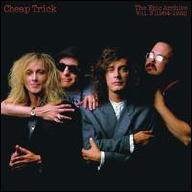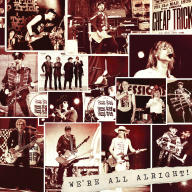Cheap Trick's roots lie in Fuse, a late-'60s band formed by Rick Nielsen and bassist Tom Petersson in Rockford, Illinois. The group released an album on Epic in 1969; after it failed to gain any attention, the band relocated to Philadelphia and changed their name to Sick Man of Europe. The group toured Europe unsuccessfully in 1972 and returned to Illinois in 1973. Not long after their return to Rockford, Nielsen and Petersson changed their band's name once more -- this time to Cheap Trick -- and added drummer Bun E. Carlos and vocalist Randy Xeno Hogan to the lineup. Hogan was fired the following year, making room for ex-folksinger Robin Zander to join the group. Between 1975 and the band's first album in 1977, Cheap Trick toured constantly, playing over 200 concerts a year while occasionally opening for the likes of the Kinks, Kiss, Santana, AC/DC, and Queen. During this time, the band built up a solid catalog of original songs that would eventually comprise their first three albums; they also perfected their kinetic live show.
Cheap Trick signed with Epic in 1976 and released their self-titled debut early the following year. The record sold well in America, yet it failed to chart. However, the group became a massive success in Japan, and the album went gold upon release. Later that year, the band released their second album, In Color. It backed away from the harder-rocking side of Cheap Trick, featuring slicker production and quieter arrangements that spotlighted the band's melodic skills instead. Due to their constant touring, the record made it into the U.S. charts, peaking at number 73. It became another gold-seller in Japan, however, where the musicians had become virtual superstars. Their Japanese concerts began selling out within two hours, and they packed the sizable Budokan Arena.
Cheap Trick's concerts at Budokan were recorded for possible release, although the live album didn't appear until the band's third album, 1978's Heaven Tonight. That third album captured both the loud, raucous energy of Cheap Trick's debut and the hook-laden songcraft of In Color, leading to their first Top 100 single, "Surrender," which peaked at number 62. However, the live performances on At Budokan (1979) captured the band's energetic, infectious live show, resulting in their commercial breakthrough in America. The album stayed on the charts for over a year, peaking at number four and eventually selling over three million copies. Meanwhile, a live version of "I Want You to Want Me" became their first Top Ten hit. Later that year, the group released their fourth studio album, Dream Police, which followed the same stylistic approach as Heaven Tonight. It also followed At Budokan into the Top Ten, selling over a million copies and launching the Top 40 hit singles "Voices" and "Dream Police." In the summer of 1980, the group released an EP of tracks recorded between 1976-1979 called Found All the Parts.
Following the recording of the George Martin-produced All Shook Up, Petersson left the group in the summer of 1980 to form a group with his wife, Dagmar. He was replaced by Jon Brant. Released toward the end of 1980, All Shook Up performed respectably, peaking at number 24 and going gold, yet the single "Stop This Game" failed to crack the Top 40. One on One, the group's seventh album and the first recorded with Brant, appeared in 1982. Although it peaked at number 39, the record was more successful than All Shook Up, eventually going platinum. Nevertheless, the group was entering a downhill commercial slide, despite the fact that its music was becoming increasingly polished. Next Position Please, released in 1983, failed to launch a hit single and spent only 11 weeks on the charts. Standing on the Edge (1985) and The Doctor (1986) suffered similar fates, as the group were slowly losing their creative spark.
Petersson rejoined the band in 1988 and the group began work on a new record with the help of several professional songwriters. The resulting effort, Lap of Luxury, was a platinum Top 20 hit, featuring the number one power ballad "The Flame" and a Top Ten version of Elvis Presley's "Don't Be Cruel." Busted, released in 1990, wasn't as successful as Lap of Luxury, peaking at number 48 and effectively putting an end to the group's commercial comeback.
Cheap Trick soldiered into the new decade by signing with Warner Bros. in 1994 and releasing Woke Up with a Monster, which peaked at number 123 and spent two weeks on the album chart. That same year, Epic released a sequel to At Budokan, aptly titled Budokan II. Compiled from the same shows as At Budokan, the record served as an effective reminder of why the group had become so popular in the late '70s.
In 1995, Cheap Trick asked to leave Warner's roster after the label's chief executives, Lenny Waronker and Mo Ostin, departed. The band then decided to go back to the basics, and several alt rock superstars who had been influenced by Cheap Trick gave the band opportunities to restore their reputation. The Smashing Pumpkins had them open their tour in 1995, and the group played several dates on the 1996 Lollapalooza Tour. That same year, the box set Sex, America, Cheap Trick appeared to positive reviews, and the band signed with the fledgling indie label Red Ant before setting to work on a new album. Early in 1997, the group released a Steve Albini-produced single on Sub Pop, which was followed by the eponymous Cheap Trick, their acclaimed debut for Red Ant, in the spring. Unfortunately, Red Ant filed for bankruptcy seven weeks after the album's release, sadly putting a sudden halt on the group's building momentum.
On April 30, 1998, the group launched a four-night residency in Chicago, devoting each show to reprising one of their first four albums in its entirety. Those shows later yielded a 1999 live LP, Music for Hangovers, which the musicians issued on their own Cheap Trick Unlimited label. A band-authorized hits collection followed in 2000. By the dawn of the new millennium, Cheap Trick were still without a label, but had retained their loyal following by continually touring the world. Appropriately, another live set saw the light of day in 2001. Entitled Silver, the double-disc album (and companion DVD) documented the band's star-studded, career-spanning 25th anniversary show on August 28, 1999. The band also recorded another studio album, released in 2003 as Special One. It was followed in 2006 by Rockford, named in tribute to the band's hometown, and then The Latest in 2009. Cheap Trick also maintained a heavy touring ethic, canvassing America that summer alongside Def Leppard and releasing their tribute to the Beatles with Sgt. Pepper Live. In late 2015, Cheap Trick signed with powerhouse country label Big Machine Records, and their first album for their new sponsors, Bang, Zoom, Crazy... Hello, was released in April 2016--the same month the group was inducted into the Rock & Roll Hall of Fame. It was the first Cheap Trick release since the departure of drummer Bun E. Carlos. Daxx Nielsen, Rick's son, became the group's new percussionist in 2010. Wasting no time, they returned with their second album for Big Machine, the rollicking We're All Alright!, in June 2017. They had barely caught their breath when they were back with their first holiday album, Christmas Christmas, in October 2017. After spending much of their time playing every stage that would have them, the group returned with a studio album in 2021. In Another World conjured up memories of early albums, with both Nielsen and Zander performing with the zeal of men far younger. A much earlier version of the band was trotted out in all their strutting glory on the 2022 archival release Live at the Whisky 1977. Recorded while the band was in the midst of working on In Color, the four complete live shows capture a raucous, guitar-heavy side of the group that their studio albums don't. When it was released near the end of 2022, the band had just finished a U.S. tour. ~ Stephen Thomas Erlewine & Greg Prato, Rovi

















